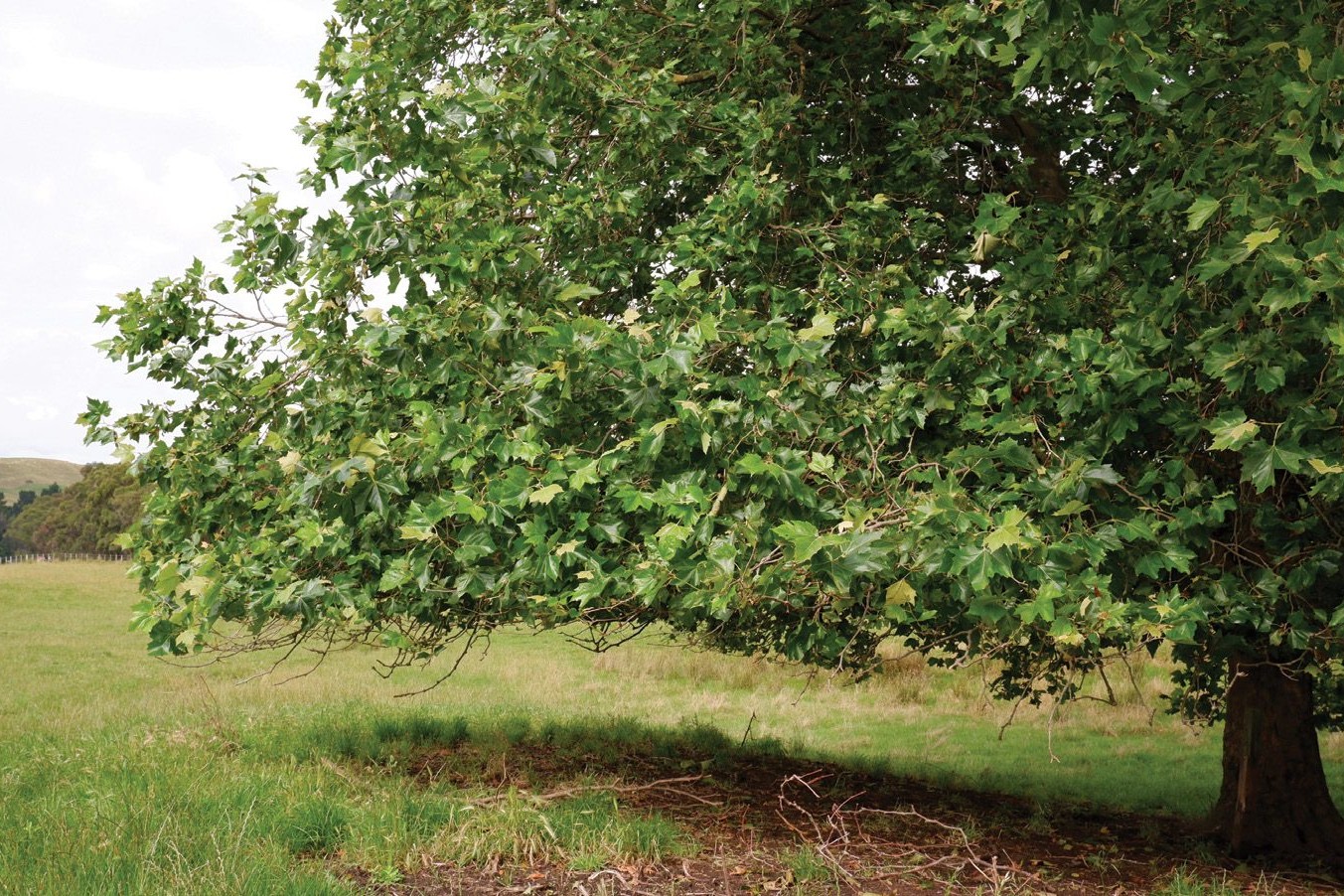Planting for stock food and shelter
Most New Zealand farms are very efficient grass factories, some are treeless, grass deserts, but all could be made slightly more productive by planting some fodder trees, Peter Arthur writes.

Most New Zealand farms are very efficient grass factories, some are treeless, grass deserts, but all could be made slightly more productive by planting some fodder trees, Peter Arthur writes.
Most fodder trees I mention are deciduous, which means they drop their leaves in autumn, allowing light to keep the grass growing. In spring they put out fresh new leaves and then when the heat of summer hits, stock have a patch of shade to sit under.
Dairy cows with shade out-produce those with none. Trials have proved those with shade produce more milk than those exposed to the full blast of the summer sun. It’s easy to measure milk production, but not so easy to measure shade benefits for sheep and cattle.
Fodder trees fall into three main groups: foliage, fruit and nuts.
For foliage, the easiest trees to grow are poplars, willows and tree lucerne. All are good standbys for drought conditions. The poplars can be pruned when there is a drought, which not only feeds the stock but also relieves drought stress on the trees.
Poplars are easily planted as poles but initially need plastic protectors to stop animals chewing the bark. Some poplars have been bred to be possum resistant – that is, their foliage is not palatable to them, but I don’t know whether the same applies to sheep and cattle. Poplar leaves are high in zinc, particularly Populus yunnanensis. Autumn falling leaves are eagerly consumed by sheep and cattle and I’ve watched sheep rush towards a leaf as it heads towards the ground.
Willows can also be grown from poles, and once they are tall enough can be pollarded. This means cutting off all the branches above stock reach. The tree will quickly grow more branches that can be left till the next dry spell. There is a bit of an art to pollarding the first time so that when the second harvest is made there is a nice framework to stand on when wielding the chainsaw. You need a ladder, or else a motorised pole saw.
The weeping willow just keeps weeping and the stock can browse whatever they can reach.

Pain killers in bark
Willows and poplars both contain salicin, mostly in the bark. This is the chief ingredient of aspirin and other pain killers.
It is said some of the weeping willows in NZ originate from cuttings taken from the tree under which Napoleon was buried on the island of St Helena where he was imprisoned by the British from 1815 till his death in 1821.
Very similar in appearance and growth habit to the weeping willow is the Mayten tree from Chile. It can send up suckers some distance from the tree, but if there are cattle around they will very quickly chew them off. At one stage we only had male trees in NZ, but some nurseries introduced a female and their seed can blow for miles and be very invasive. As a result, it’s now a banned plant. I have only a few trees, which fortunately are male.
Tree lucerne, an evergreen legume, is short-lived but used as a nurse crop for growing other trees. It can be used as a shelter belt, growing up to five metres, and provided there is a gate, stock can be let in to help themselves and then, starting at the far end, a few plants can be cut every day. I planted tree lucerne too early in the winter and it was killed by frost and cold southerlies.
My best success was to pre-spray spots, mix seed with potting mix and drop a handful on each spot. Wood pigeons enjoy the small white flowers and seed pods. Tree lucerne makes excellent firewood, as good as kanuka.
Then there is the drought resistant kurrajong (Brachychiton populneus) from Australia, where it is regarded as a useful fodder tree. The few I have drop their leaves in early spring and I keep thinking frosts have killed them.
One thing I have noticed is that when cattle are put into a fresh paddock the first thing they do is check out the trees for any fresh, reachable foliage. Willows and oaks are their first preference, followed by plane trees,
Total one-offs not thought of as fodder trees include apples, apricots, plums, pears, persimmons and even figs. I have very old plum and pear trees. Cattle, sheep and wood pigeons enjoy the plums. I have a white flowered cherry plum and the pigeons start eating the fruit as soon as it starts forming – not even ripe. The tree has nasty thorns and the pigeons are spreading it everywhere where stock grazing is light. Makes excellent firewood.
Animal and human food
On the farm there was a row of different varieties of pears leading to a disused cow bail. There were early and late varieties that fruited over a period of several months and kept the house-cow happy while she was being milked. Only two of the century old trees survive today. Ten or more years ago a Taihape farmer was planting pears as shelter and fodder belts, but I’ve never heard how that’s worked out.
Not far from here is an abandoned apricot orchard (fire blight killed many of the trees but not all of them). Stock relish the fallen fruit. An added bonus for the fruit trees is the stockman can have a feed as he passes by. Several years ago a Gisborne farmer asked me what trees he should plant by the stock yards. Before I could answer he decided on citrus because he liked eating them.
Finally there are the pod and nut producers. I have about 200 honey locusts planted on a mostly north facing, steep hillside. Probably half the trees are male, which produce nothing, but a good female can produce up to 300kg of nutritious, 30cm-long seed pods. It is a popular fodder in South Africa where they use long poles to beat the pods off the trees. In NZ, the pods stay on the tree till late winter and when they fall they are dried out like strips of boot leather. However, the cattle enjoy munching away at them.
Carobs are a similar pod-producing tree that revel in hot and dry conditions but don’t like frosts. The pods are used to make carob drinks and carob chocolate, and cattle love them. They are high in sugar and rich in protein.
Sheep, cattle, pigs, ducks and turkeys all love acorns, and some oaks have heavy crops one year but not the next. Again, like falling poplar leaves, I have watched sheep looking up, waiting for another acorn to fall.
Acorns have killed stock in fenced, oak-lined driveways where there is nothing else to eat but acorns, but in a paddock situation they are perfectly safe. The white oaks – the English oak is one – have sweeter acorns than the red oaks, though I’ve seen acorns lying 15cm deep in a park crawling with ducks. There were a lot of other oaks in the park with not an acorn to be seen. Must have been very bitter.
Some sheep learn to eat sweet chestnuts, using their feet to prise them out of their prickly casings, and pigs and turkeys like them.
Stock will eat the foliage of virtually any tree they can get at, and apart from being a pleasant change from grass, they are probably getting all sorts of useful minerals. Some leaves are said to have anthelmintic properties.




